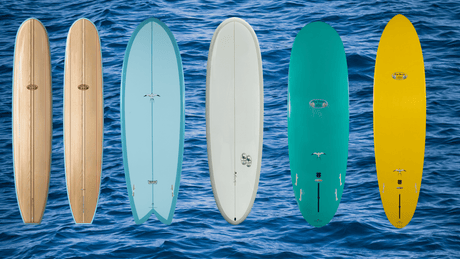Thickness, closure, cut, use, maintenance, composition, high-end... Many factors must be considered before choosing your surf wetsuit. In this article, we reveal our best tips to help you choose your next gem! This choice is essential to ensure your comfort and thus maximize your performance in the water. We have listed three main sections with the criteria that seem most important to us, as well as a final paragraph on the maintenance of your surf wetsuit. Enjoy your reading!
1. Choose your wetsuit according to the water temperature

Hot water :
More than 19°C. Whether it's summer in France or the rest of the year in the tropics, forget the full suit! Depending on the temperature, you can adjust your protection. Lycras, rash guards, shorties, or springsuits, the choice is wide. The key is to choose a piece that is thin, light, and flexible enough to maximize your comfort.

- For really warm tropical waters (above 23°C), opt for lycras or surf-tees for more lightness and mobility. They provide good protection against UV rays. These models also offer good freedom of movement and ideal buoyancy. All you need now is your boardshorts or bikini, a good application of sunscreen, and off you go!
- For warm waters (below 23°C), opt instead for a lightweight suit like a shorty or springsuit. Even if the water is pleasant, you can quickly feel cold after a long session. This is the best option for moderate heat retention. Their common feature: they keep the upper body warm and stay snug against the skin.
Thickness: less than 2/2mm.
Protection level: Light. Summer, tropics.
Water temperature: 19-26°C.
Temperate waters :
Between 15°C and 19°C. Below 19°C, the use of a neoprene wetsuit is strongly recommended. Also called steamers, these are full suits with long sleeves and legs. They offer an optimal and moderate thickness distribution (3mm on the torso and 2mm on the legs and arms). Ideal for mid-season or even summer for those who are more sensitive to cold. They differ in the many existing thicknesses, seams, and various technologies in terms of composition (ecological, Yulex, etc). The most versatile for temperate waters remains the 3/2mm.
Thickness: 3/2mm.
Protection level: Medium. Mid-seasons, spring/autumn.
Water temperature: 15-19°C.
Cold waters :
Below 15°C. Winter water temperatures require a full wetsuit. This is often accompanied by neoprene accessories such as booties, hoods, and gloves. Discover below our selection of neoprene accessories specially designed to protect you from the cold.- For cold waters up to 12°C, the essential wetsuit is the 4/3mm, the most versatile for cold water. It is still recommended to pair it with a pair of neoprene booties.
- For even colder waters below 12°C, we recommend a 5/4mm type wetsuit. Some models even have an integrated hood. If not, combine it with neoprene booties, hoods, and gloves. For these temperatures, accessories are mandatory! Cover yourself from head to toe to be sure to avoid any heat loss! Remember that it is better to be too covered than not enough.
Thicknesses: 4-5/3mm; 5/4mm.
Protection level: High. Winter, cold country.
Water temperature: Below 15°C.
2. Depending on its morphology and the different technologies (neoprene and seams)
The shapes and different sizes of suits
A wetsuit must be worn very close to the body. It should have no visible folds. The goal is to achieve the best possible thermal efficiency. It is true that putting on a completely dry wetsuit is far from pleasant... You feel too tight or uncomfortable but this sensation disappears upon contact with water, that's a promise! Obviously, each brand has its own size guide. However, you have probably noticed that the names are sometimes quite distinct. Generally, for women, brands use a particular size guide with numbers: 6 / 8 / 10, like Rip Curl for example. For men, size guides are almost like those for clothing, but with a small subtlety. Example: S / MS / M / MT / L... Surf brands offer intermediate sizes "Small" or "Tall" which refer to body height. So, if you wear an M in clothing and you are quite tall, you should choose an "MT" size (Medium - Tall). Whereas the classic sizes "M", "L" correspond to so-called standard bodies. Below are two size guides from the same brand, the first for women and the second for men.


Our best advice is not original but very important: always trust the size guide of the brand of the wetsuit in question. A Ripcurl surf wetsuit in size M will not have the same measurements as a Patagonia surf wetsuit in M. On our site HawaiiSurf, the size guide is always indicated on the product page.
Alternative materials to neoprene: technologies and eco-responsibility
Standard neoprene
This is the most common and cheapest type of neoprene. It offers good thermal insulation and some flexibility, but it is generally less comfortable and heavier than other types of neoprene. Standard neoprene wetsuits are usually used by beginner or occasional surfers. O'Neill is a well-established brand in the surfing world and offers surf wetsuits with standard neoprene. For example, their "Epic" range offers affordable wetsuits in standard neoprene.
Closed-cell neoprene
This type of neoprene has a closed-cell structure, which means that air is trapped inside the material's cells. This offers better thermal insulation than standard neoprene, but it is generally stiffer and less flexible. These are often used for water sports practiced in cold waters, such as scuba diving or winter surfing. Rip Curl also produces closed-cell neoprene wetsuits. The "Flashbomb" model features this technology. These wetsuits use E5 Flash Lining neoprene, which is designed to offer superior thermal insulation and rapid water drainage.
Superstretch neoprene (super flexible)
This is a type of high-quality neoprene that offers excellent flexibility and great freedom of movement. Superstretch neoprene wetsuits are more expensive than standard neoprene ones, but they are highly appreciated by advanced and professional surfers for their comfort and performance. The HyperFreak range from O'Neill uses TechnoButter 3 neoprene, which is an evolution of their TechnoButter technology. TechnoButter 3 is a superstretch neoprene that offers excellent flexibility, superior thermal insulation, and quick drying.
Eco-friendly neoprene
More and more surf wetsuit manufacturers are environmentally conscious and offer eco-friendly neoprene options. These models are made from recycled materials or renewable resources, such as oyster shell powder, limestone, or vegetable oils. Eco-friendly neoprene wetsuits offer performance similar to traditional neoprenes, but they can be slightly more expensive due to higher production costs. Patagonia is a brand focused on sustainability and the environment, and they have developed eco-friendly neoprene wetsuits based on natural rubber Yulex. Their range "R" (like "R1", "R2", "R3") offers wetsuits with different levels of thickness and warmth.
The different sewing technologiesThe type of stitching is also an important point to consider to ensure waterproof performance. It is the element that can make the difference between several neoprenes of the same thickness. There are therefore several stitching technologies.
- Basic seams: These are found on all entry-level suits. However, they provide good waterproofing but are not very flexible.
- Flatlock seams: These seams are improved. The neoprene panels are assembled edge to edge and sewn together. They are known to be more flexible and strong but also more comfortable on the skin.
- Stitched/glued seams or GBS: Also called invisible or watertight seams. They are formed by gluing the two neoprene panels together and sewing them with a special needle that does not fully penetrate the neoprene. This technique significantly reduces water leakage, making it a good option for high-end surf suits. To spend even more time in the water, intermediate and high-end models have internal watertight tape over the seam. A liquid rubber process is applied to the external seams to improve watertightness and durability.
In general, the more watertight the seam, the more expensive it will be and the less flexible it will be. It is therefore important to choose a surf suit with the seam technology that best suits your needs and budget. As you can see, to maintain good watertightness, seams are important. Any water entry can ultimately come from the zipper. Here are the two main types of zippers you can find on neoprene suits.
3. Depending on the zipper closure of your wetsuit
So back zip or chest zip? This is certainly the most frequently asked question regarding the closure of surf wetsuits! Come on, we'll give you a little comparison of the two to clarify this topic and help you determine which one suits you best.
The "Back Zip" zipper
The original, the classic, even the historic! Indeed, the back zip is the closure of the first surf suits. The zip is located on the back, along the spine. It therefore requires closing at the back, often accompanied by a tab to make it easier for you and a Velcro strap to close the suit.

The advantages
- Ease: It is easier to put on and take off a back zip wetsuit because the opening is larger than on a chest zip. Ideal for beginners!
- Comfort: The closure is located at the back, so it does not interfere at the front during rotational and bending movements.
- Adaptability: This system adapts to all body types. Notably thanks to its wide opening but also because of its Velcro at the collar for an ideal fit.
The disadvantages
- Water leaks: The zipper being longer and on the back, it is more prone to water infiltration. This can lead to a decrease in warmth and therefore performance.
- Limited access: Having the closure on the back can make access more difficult. It also offers slightly less freedom of movement than the Chest Zip.
- Discomfort: Some surfers may find that the zipper on the back can cause discomfort, especially when it rubs against the back or when it is tight. But this issue remains quite minor!
The "Chest Zip" zipper

The new one! A closure that changes the rules. The chest zip, unlike the original back zip, is located at the front at chest level. This one opens from the side and allows for better waterproofing. Often appreciated by experienced surfers, we explain everything about this innovation.
The advantages
- Better sealing: Provides better sealing and reduces water ingress.
- Increased mobility: Greater freedom of movement to row more easily and surf more effectively.
- Comfortable: Surf suits with chest zip closures often have less material on the back, making them more comfortable to wear.
The disadvantages
- Harder to put on: Often more difficult to slip on than wetsuits with a back zipper. This can take a little more time.
- Costly: These are generally more expensive than back zips due to the design and quality of the materials used.
- Maintenance: The chest zip requires regular maintenance to ensure its proper functioning. Zippers can also be more prone to wear and may need to be replaced more frequently than back zip suits.
 Ultimately, the choice between a chest zip wetsuit or a back zip wetsuit depends on your personal preferences and surfing style. If you are looking for better sealing and greater freedom of movement, a chest zip closure might be the ideal choice. However, if you prefer a wetsuit that is easier to put on and less expensive, then the back zip wetsuit is made for you!
Ultimately, the choice between a chest zip wetsuit or a back zip wetsuit depends on your personal preferences and surfing style. If you are looking for better sealing and greater freedom of movement, a chest zip closure might be the ideal choice. However, if you prefer a wetsuit that is easier to put on and less expensive, then the back zip wetsuit is made for you!
4. Maintenance of your wetsuit
Maintaining your wetsuit is essential if you want to keep it intact for as long as possible. Adopt these few habits regularly to extend its lifespan and maintain its thermal and waterproof properties. Here are our 5 best tips for regular and optimal maintenance: 1. Rinse after each session: After each surfing session, rinse your wetsuit with fresh water to remove salt, sand, etc. Make sure to rinse both the inside and outside of the suit. 2. Dry properly: Avoid leaving your wetsuit in the sun (neoprene hates that!) or drying it in a machine. Hang it in the shade in a well-ventilated area and turn it regularly so it dries evenly. Also avoid hanging it on a hanger by the shoulders. This can cause neoprene deformation…
3. Avoid heat sources
Avoid placing your wetsuit near heat sources. This can damage the neoprene fibers and make them less durable.
4. Use maintenance products
There are products specially designed to maintain wetsuits, such as neoprene cleaners (like piss-off !). Use them according to the instructions to keep your wetsuit in good condition. Regarding the cleaning frequency, it all depends on how often you use your wetsuit. If you surf every day, then cleaning once a month is necessary. If its use is less regular, opt for a thorough wash every 3 to 6 months!
5. Avoid chemicals
Avoid using chemicals such as detergents or bleaches. These products can damage the neoprene and reduce the lifespan of your wetsuit.

By following these maintenance tips, you can extend the lifespan of your wetsuit and maintain its thermal protection and waterproof properties for many surf sessions to come. If you follow all these tips, the lifespan of your wetsuit can be up to 10 years. It all depends on usage! Normally, after reading this article, wetsuits will have no secrets for you! You know everything about the important criteria before making your choice. Thicknesses, sizes, neoprene technologies, seams, or zippers are all equally important elements. Price, aesthetics, or even the appeal of a certain brand will of course play a significant role in your decision-making. If you have any questions, our customer service will be happy to advise you! See you next week for a new blog article!
Camille, HawaiiSurf.










